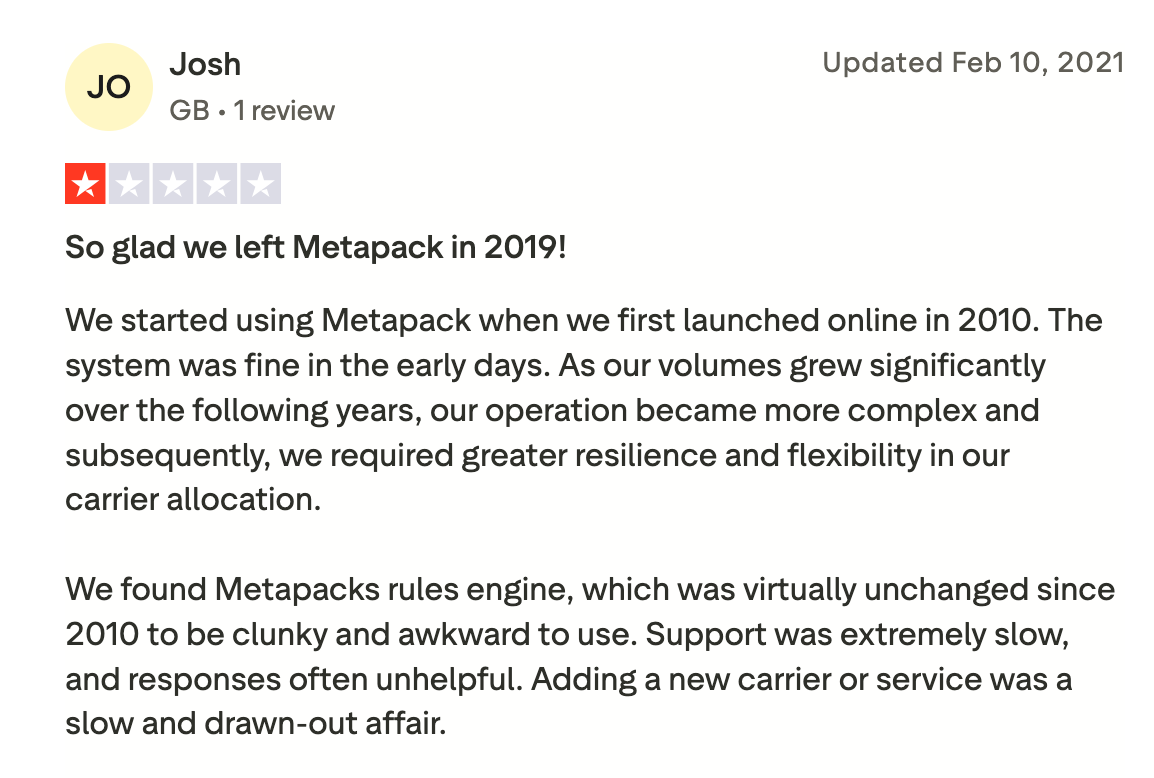As a 3PL or shipping technology platform, how you design your carrier network, will have a direct impact on a client’s brand. The end customer’s trust hinges on the delivery promise made at checkout. A poor experience, whether in outbound or returns, means a lost customer, as 79% of consumers say a bad post-sale experience, stops them repeat purchasing.
However, many platforms focus too much on basic carrier selection and technical integration, ignoring the critical design and build phase. This is where the real-world impacts, both on operational cost and consumer experience are decided.
The problem typically lies in a lack of deep commercial and operational knowledge. For example, not fully understanding a carrier’s complex commercial models leads to huge, unexpected surcharges that destroy a 3PLs margins on rates and increase overall operational costs. On the consumer-facing side, if the network design fails to properly analyze and integrate PUDO (Pick-Up Drop-Off) points, the retailer can offer fewer options at check-out, leading to cart abandonment.
Real World Examples:
Sendle:
When analysing their documentation, it can lead you to believe they don’t offer PUDO points. It’s then common that an analyst misses they have partners for this, they’ll miss USPS being used for the US market and Australia Post for the Austrian market. Directly impacting what shows at check-out.
One Stop Shop API:
Some carriers in Europe list an API covering regions, with all services available. However, when building and testing an integration, not all services are available when calling an Endpoint. A common example is Cash on Delivery in the CEE region. Many promise this but don’t deliver on it. The impact is a large drop in basket conversion, in regions including Greece, Bulgaria, and Slovakia (81%+ COD), not having their desired delivery & method makes you uncompetitive and untrustworthy.
Thinking beyond the technical API of a carrier
Your carrier integration stack is no longer just about adding APIs. It’s about the quality of that integration and the functionality to control the delivery experience. Many partners still build networks manually, using teams with limited industry knowledge. This results in a “one-size-fits-all” design that fails to deliver on a retailer’s specific brand promise.
In contrast, modern, AI-powered platforms can go beyond simple integration. They analyze the real-world operations of each carrier, giving retailers the flexibility to build an adaptable network. This data-driven approach ensures the chosen services and experiences match the brand’s needs, turning the final mile into a true competitive advantage.
An evaluation of suitable solutions for your Delivery experience
To help you find such a solution, we evaluated more than 20 carrier-integration platforms. Based on industry reviews (G2, Trustpilot, Capterra) and direct feedback from 3PLs and shipping tech providers on their biggest pain points, we selected ten companies commonly used for creating a carrier network.
We will expand on these platforms’ services, capabilities, and flaws. But first, we highlight the three most common challenges to avoid during your selection process:
Three Common Platform Challenges and Their Real-World Impact
1. Onboarding Friction and Long Time-to-Live
Adding new carriers or connecting systems often takes weeks, if not months. This means a critical loss of agility. Most can’t quickly test a new, more sustainable carrier, or rapidly replace a provider who is failing during peak season (Like Canada Post Strikes). For the end-consumer, this translates to a stale and uncompetitive experience; they see rival stores offering new, convenient delivery options (like a specific local courier or PUDO network), while your brand remains stuck with the same limited, slow, or costly choices.


2. Legacy Systems Blocking Growth
Most platforms are built on outdated technology missing advanced capability, limiting scalability and incurring large cost. In the real world, these systems can crash on Black Friday, causing huge fall-out. For a 3PL, this tech debt means they can’t offer modern, complex services like automated returns, or flexible in-flight changes (e.g., “deliver to a neighbor”). For the customer, the experience is basic and inflexible, feeling years behind the competition.

3. Data Quality Gaps and System Instability
Many platforms suffer from poor data quality, including flawed carrier mappings and API instability. These system glitches then explode during high-volume periods, creating a flood of “Where Is My Order?” (WISMO) inquiries that damage brand trust and dramatically increase operational costs for you.

An Evaluation of Platform to scale your Carrier Network
This landscape highlights the difference between basic integration and intelligent carrier network design.
Best-in-Class Solution
Synkka
- Bio: An AI-native platform built to Build and manage your delivery network, not just integrate it. Synkka goes beyond basic APIs by using deep commercial and operational knowledge to model real-world impacts, ensuring your network is cost-effective and delivers on your brand promise.
- Best for: 3PLs, shipping platforms, and cross-border who need to turn delivery into a competitive advantage by optimizing for speed, operational cost and consumer experience.
Key Advantages:
- Commercial & Operational Design: Uses AI to analyze carrier models, helping you avoid hidden surcharges and false service promises to design a network that truly fits your business.
- Real-World Data & Stability: A modern, reliable platform provides high-quality, live tracking data, which reduces costly “Where Is My Order?” (WISMO) inquiries and improves the customer experience.
- Flexibility & Speed: Rapidly builds and adapts your network, allowing you to add new carriers, services (like PUDO), and more options without the months-long delays of legacy platforms.
Other Common Platforms
MetaPack
- Bio: The oldest enterprise platform, valued for stability but weighed down by legacy tech (EDI) and slow processes.
- Best for: Global enterprises prioritizing customisation over implementation speed.
- Key Challenge: Slow, complex integrations and an outdated tech stack lead to high costs and months-long delays for simple change requests. Paired with recurring latency issues.
- Review Score: 2.8 / 5
nShift
- Bio: A Nordic suite for checkout, shipping, and tracking.
- Best for: High-volume European retailers who need a single system without huge concern for performance.
- Key Challenge: Unreliable platform performance (outages, lag) and extremely poor customer support, leading to unresolved issues during peak periods.
- Review Score: 1.4 / 5
Sendcloud
- Bio: A simple, automation-focused platform for smaller businesses.
- Best for: SMBs needing a low-friction, affordable tool.
- Key Challenge: Pushes its own “middleman” carrier rates, leading to unclear pricing and unexpected surcharges. Also limited capability to handle complex operations and support.
- Review Score: 4.2 / 5
Centiro
- Bio: An enterprise platform focused on deep (but costly) customization.
- Best for: Large organizations with unique workflows that can absorb high development costs.
- Key Challenge: Manual custom-build for each new carrier. Nothing pre-tested and out of the box. Resulting in long and expensive projects.
- Review Score: 3.5 / 5
ShipEngine / ShipStation
- Bio: Developer-focused APIs and simple dashboards for the US market.
- Best for: US-based SMBs and middle-market retailers.
- Key Challenge: Unclear billing with unexpected hidden fees and system glitches that disrupt daily operations. Recurring latency issues.
- Review Score: 2.9 / 5
EasyPost
- Bio: A flexible, API-first integration tool for developers.
- Best for: Developers needing quick, simple multi-carrier API access without much complexity.
- Key Challenge: API reliability issues, including downtime and connectivity disruptions. Weaker carrier coverage and support in Europe.
- Review Score: 1.9 / 5
Easyship
- Bio: Shipping platform for SMB that helps businesses save money by comparing rates.
- Best for: Small brands scaling internationally needing landed-cost clarity.
- Key Challenge: Poor API reliability and inconsistent customer support, causing connectivity issues and delayed resolutions.
- Review Score: 1.9 / 5
ShippyPro
- Bio: A shipping solution for the European parcel market.
- Best For: Its great UI and customer support for SMB brands webshows across Europe
- Key Challenge: Rising, non-transparent pricing and a complex setup that often delays onboarding.
- Review Score: 4.3 / 5
AfterShip
- Bio: A post-purchase platform focused on branded tracking pages, not operations.
- Best for: Brands wanting to improve post-purchase communication.
- Key Challenge: Inconsistent tracking data with delayed or incorrect shipment updates, confusing customers and increasing “Where Is My Order?” (WISMO) tickets.
- Review Score: 2.8 / 5
Summary: Move Beyond Basic Integration and Selection
As this list shows, most platforms are just carrier integrators, building carrier connectivity with limited consideration for real world operation. They are often slow, inconsistent, and unreliable, forcing you to choose a partner that inhibits your growth.
When planning your carrier network, you need to plan for the future. Synkka’s AI-native platform is different. It goes beyond basic integration to help you design the best possible delivery network, using the deep commercial and operational knowledge other platforms ignore.
This approach ensures you can avoid surcharges, offer more options at checkout, and provide live, reliable tracking. While other platforms are stuck, Synkka’s AI agents provide a reliable platform that runs your operations smoothly in any environment.
If you are interested in working with a partner that will scale alongside you, Book a Demo.


.jpg)

